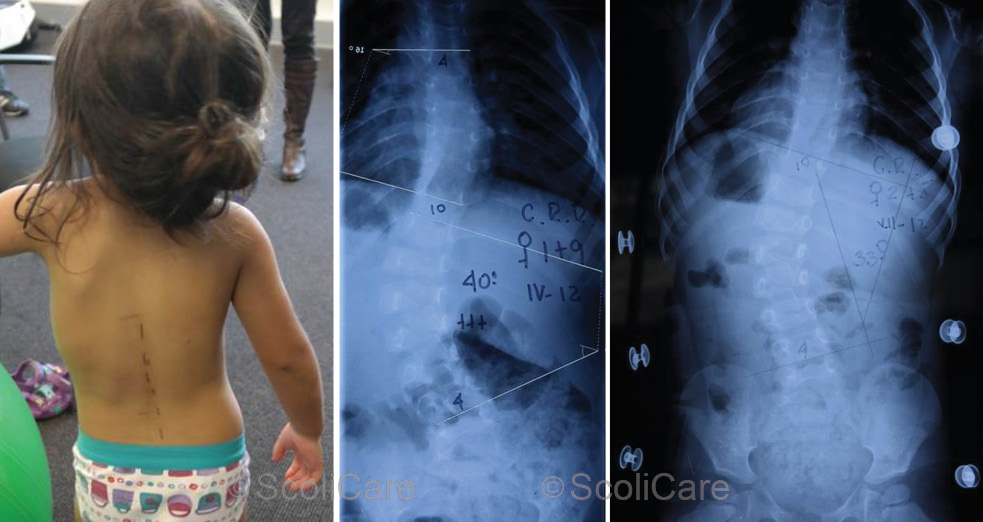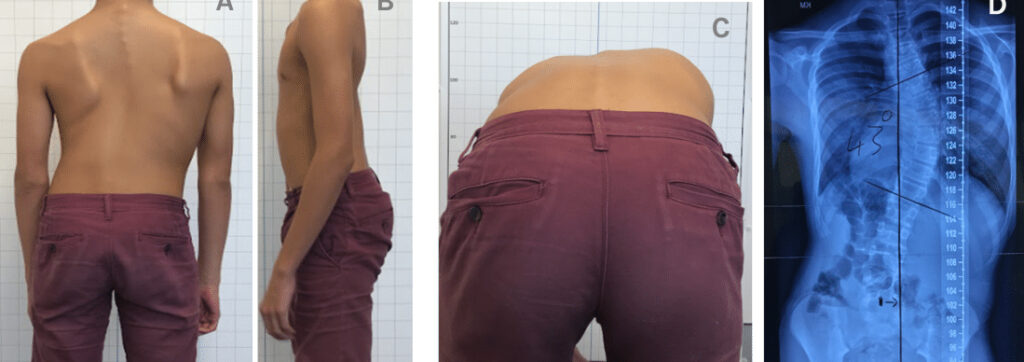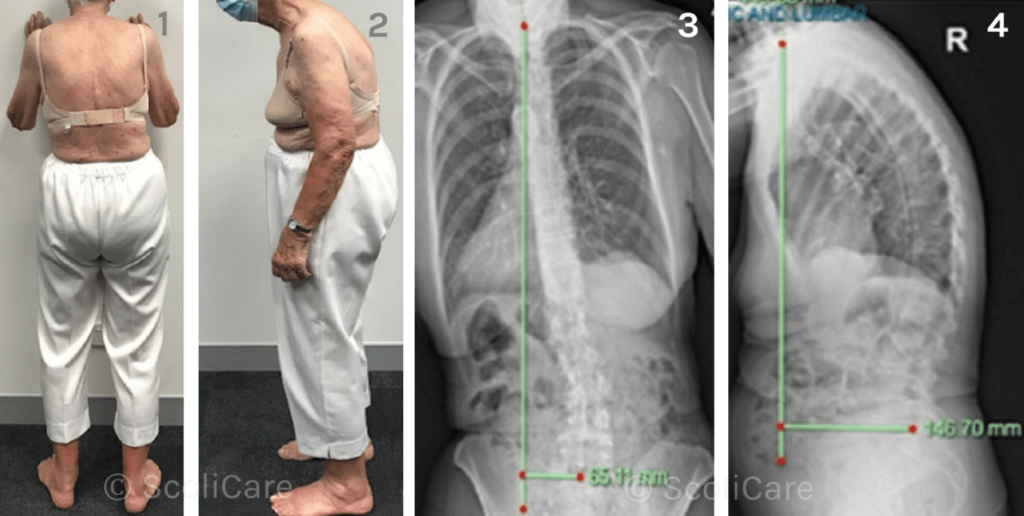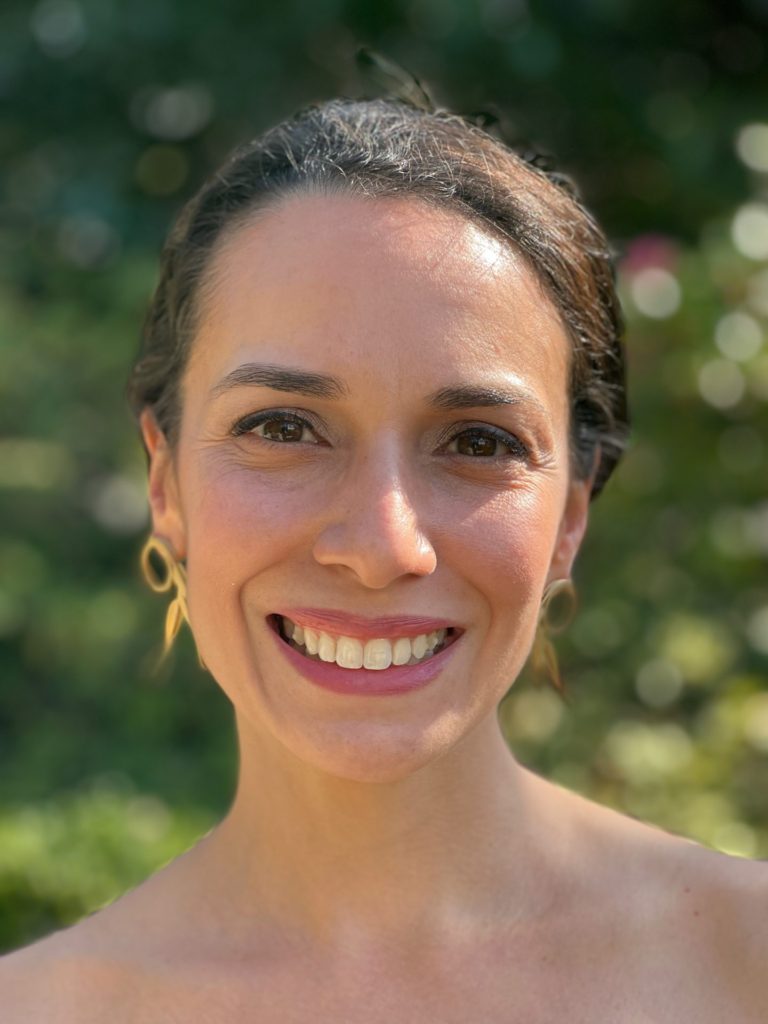Understanding Scoliosis at Every Age
Infantile Scoliosis
Overview
Infantile idiopathic scoliosis is a rare and unique form of scoliosis that affects children under the age of 3. This condition is characterized by an abnormal curvature of the spine to the right or left, which can manifest in the shape of an “S” or a “C”. Despite its rarity, accounting for less than 1% of all scoliosis cases, infantile idiopathic scoliosis is significant due to its potential to severely impact a child’s development if not addressed appropriately.
Diagnosising Infantile Scoliosis
There are two main categories of infantile idiopathic scoliosis: resolving and progressive. Resolving scoliosis, which constitutes about 80% of cases, tends to spontaneously correct itself as the child grows. In contrast, progressive infantile idiopathic scoliosis worsens over time and requires intervention to prevent severe deformity. Advanced imaging techniques like spinal MRI are essential for confirming diagnoses and excluding other potential causes of scoliosis.
The distinction between these two types hinges on the degree of the spinal curve and the rib vertebral angle difference (RVAD), with a significant RVAD indicating a higher likelihood that the scoliosis will not resolve on its own. For curves measuring less than 20 degrees of Cobb angle, observation is typically recommended, whereas larger curves with moderate RVAD may necessitate treatment, such as serial casting or bracing, to mitigate progression.
Managing Infantile Scoliosis
In summary, while infantile idiopathic scoliosis presents challenges in diagnosis and management, a combination of regular monitoring and early intervention can lead to successful outcomes, allowing affected children to lead healthy, active lives. The ongoing research into the causes and treatments of this condition holds promise for improving the prognosis and quality of life for these young patients.
Juvenile Scoliosis
Overview
Juvenile idiopathic scoliosis is a medical condition affecting children primarily between the ages of 3 and 9, where the spine develops an abnormal curve, resembling the shape of an “S” or a “C”. This curvature can tilt to the left or right, and it is observed more frequently in girls compared to boys.
The condition is part of a group known as idiopathic scoliosis, meaning its exact cause remains largely unknown, though it has been linked to genetic factors and possibly issues with proprioception, or the awareness of body position in space. This can lead to a progressive misalignment of the spine as the child grows, necessitating careful monitoring and treatment to prevent severe complications.
Diagnosing Juvenile Scoliosis
Diagnosis of juvenile idiopathic scoliosis often occurs incidentally during routine check-ups or may be flagged by parents or school health screenings. The initial suspicion is usually confirmed by a physical examination and X-ray imaging, which can clearly show the extent of the spinal curvature. A curvature greater than 10 degrees, as measured by the Cobb angle on X-ray, is indicative of scoliosis. Additional diagnostic steps might include a neurological exam to rule out other conditions that could affect the spine and sometimes an MRI to provide a detailed view of the spinal anatomy and identify any other potential concerns.
Treatment Options for Juvenile Scoliosis
Treatment strategies for juvenile idiopathic scoliosis are determined by the curve’s severity and the child’s growth potential. For milder curves, observation with regular follow-up appointments may suffice to monitor progression. More significant curves might require interventions such as bracing to halt or slow the progression of the curvature. In cases where bracing is not effective or the curvature is severe, surgical options are considered.
These can range from less invasive procedures like inserting growing rods, which allow for adjustment as the child grows, to more definitive surgeries that aim to correct the curvature. The goal of treatment is to ensure the child can continue to grow and develop normally while minimizing the impact of scoliosis on their daily life. Despite the challenges it presents, with timely and appropriate treatment, most children with juvenile idiopathic scoliosis can lead full, active lives without significant restrictions.
Adolescent Scoliosis
Overview
Adolescent Idiopathic Scoliosis (AIS) represents the most common form of scoliosis affecting children between the ages of 10 to 18 years, characterized by an abnormal lateral S or C curvature of the spine. While the exact cause of AIS remains unknown, it is not associated with any specific syndromic, congenital, or neuromuscular condition, distinguishing it from other types of scoliosis.
The condition is more prevalent in females, with approximately 90% of scoliosis cases occurring in girls, often becoming more noticeable during puberty and growth spurts. Despite the absence of a known etiology, factors such as hormonal imbalances, asymmetric growth, muscle imbalance, and genetic predispositions are theorized to contribute to its development. Approximately 4% of children within the targeted age range develop AIS, with the condition generally identified in otherwise healthy children.
Management & Treatment
The management and treatment of AIS vary based on the severity and progression of the spinal curvature. Initial evaluation typically involves a thorough history and physical examination, focusing on developmental history, skeletal maturity, and a neurologic assessment, complemented by imaging evaluations like X-rays for precise curvature measurement. Treatment options range from conservative management, such as specific scoliosis physiotherapy and bracing, to surgical interventions for more severe cases.
Bracing, particularly effective for curves between 25 to 45 degrees, aims to halt curve progression, with dynamic braces offering potential to retrain and strengthen the spine. Concurrently, specialized physiotherapy programs are prescribed to counteract muscle weakness due to brace immobilization, focusing on strengthening back muscles and ensuring optimal spinal support.
ScoliCare for Adolescent Scoliosis
ScoliCare’s approach underscores the importance of individualized treatment, emphasizing accurate initial assessment and tailored treatment plans. The prognosis for AIS is generally better than juvenile scoliosis; however, early detection and appropriate management are critical to prevent significant progression and associated complications. Non-surgical treatments like exercise may be recommended for curves under 25 degrees, highlighting the spectrum of interventions based on individual needs.
Through a combination of specialized care and interprofessional collaboration, the goal is to manage AIS effectively, enhancing patient outcomes and quality of life while addressing the cosmetic and functional impacts of the condition.
Adult Scoliosis
Overview
Adult scoliosis is a condition affecting adults where the spine curves abnormally, with a Cobb angle (a measure of spinal curvature) exceeding 10 degrees. It primarily occurs in two forms: as a progression of adolescent scoliosis into adulthood, known as Adolescent Scoliosis in Adult (ASA), or as a new onset in adults due to spinal degeneration, termed Degenerative De-Novo Scoliosis (DDS).
ASA can either be stable or progress over time, and its identification relies heavily on comparing current X-rays to those from adolescence. DDS, on the other hand, typically emerges in middle-aged or older adults, often leading to lower back pain as the principal symptom.
Pain and Misconceptions about Adult Scoliosis
The major complaint from those suffering from adult scoliosis is lower back pain, challenging the misconception that scoliosis does not cause pain. This pain, which is severe for many, is not directly correlated with the severity of the spinal curve. Factors such as the curve’s location, with the majority being in the lower back, and the overall balance of the spine play significant roles in pain levels. Interestingly, the presence of scoliosis in adults between 50 and 80 years old can account for chronic lower back pain in up to 40% of cases, debunking the belief that scoliosis-related discomfort is predominantly a pediatric concern.
ScoliCare for Adult Scoliosis
Treatment for adult scoliosis varies, with surgery being a common but complex option, especially complicated by conditions such as osteoporosis. Non-surgical interventions, like dynamic bracing offered by ScoliCare, aim to alleviate pain by correcting posture and strengthening muscles around the spine. These braces can be used temporarily for pain relief during activities, as part of an intensive rehabilitation effort, or on a more permanent basis in severe cases. However, surgery, despite its risks and complexity, may be the only viable option for relief when other treatments fail, emphasizing the need for a tailored approach to manage the condition effectively.





